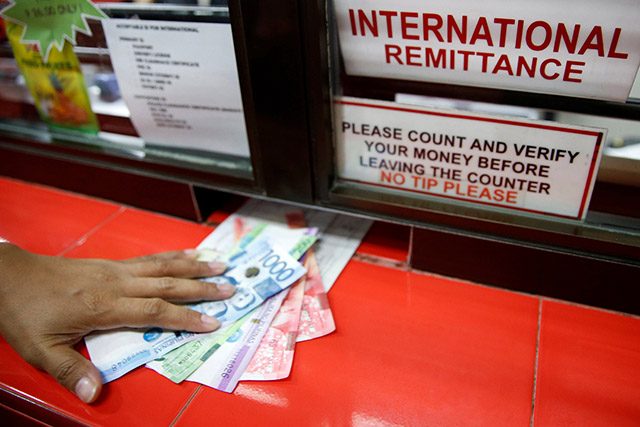
SANTA ROSA VILLAGE — Liezel Carada, who relies entirely on her husband’s earnings as a dishwasher in Italy, has seen her income grow sharply thanks to a plunge in the Philippine peso in recent years. Yet she’s having to explain to her three children that they can’t afford to go to their favorite eatery anymore.
Inflation, now at a nine-year high of 6.4 percent and running above the central bank’s 2-4 percent target for the past six months, is eroding the purchasing power of Filipino consumers, the backbone of the Southeast Asian economy.
The weaker peso, which fell to a 13-year low last week, is one major factor driving it. But even the families of the estimated 10 million overseas Filipinos who earn foreign currency are feeling the pinch as higher oil prices and heavy government spending are also pushing prices higher.
Food costs rose 8.5 percent more than they did last year and transportation is up 7.8 percent.
“We have so many expenses and the higher food prices makes budgeting more difficult,” said the 44-year old jobless Carada, who has three children, as she walked home after visiting her mother in their village of Santa Rosa, about 80 km (50 miles) south of Manila.
Reuters calculations show that over the past three years, during which the peso has been on an a rarely interrupted downtrend as the economy’s trade surplus gradually turned into a deficit, the growth in remittances is 14 percentage points higher in peso terms than in dollar terms.
But consumer price inflation is more than 11 percent in the same period, offsetting much of the growth in remittance earnings.
Raul Rivera, who works in a grocery store the size of a garage in Santa Rosa, says his customers, mostly relatives of overseas workers, are buying less than before and switching to cheaper brands.
“Those who were buying five canned goods before are now only buying three, and those who were buying 25 kilos of rice are buying just 15 or 10 kilos now,” Rivera said, adding this was the first time he noticed a change in buying patterns in the eight years he worked in the grocery.
Data shows that economic growth, which is driven mainly by private consumption in the Philippines, may be at a turning point.
Household consumption grew 5.6-5.7 percent in the first two quarters, down from 6.2 percent at the end of 2017 and rates that surpassed 7 percent the year before. The economy grew 6.0 percent in the second quarter, from 6.6 percent in the first.
It could slow down even more as the central bank has already raised rates by 100 basis points in recent months and is expected to hike further to fight inflation and keep Filipino assets relatively attractive in the face of a global sell-off in emerging markets. The central bank has said inflation should return to its target in 2019.
President Rodrigo Duterte is regarded as a rock star by many Filipinos abroad, but at home his huge popularity is starting to be tested, amid discontent over inflation, particularly the rising cost of rice, a staple for Filipinos.
His 2018 growth target of 7-8 percent, which is similar for each year until the end of his current term in 2022, now looks ambitious.
The impact of inflation “is being felt across different income classes,” said Manila-based ING economist Joey Cuyegkeng, adding that slowing consumption and a widening trade deficit prompted him to trim his 2018 growth forecast to 6.3 percent from 6.7-6.8 percent. He expects the central bank to hike by 50 basis points this month.
Backstop
To be sure, remittances – which come in at an average rate of about $2 billion a month – are still an important backstop for the economy, financing a staggering two thirds of its monthly trade deficit. Remittances for July were $2.4 billion, up 5.2 percent year-on-year.
Santa Rosa is not a bustling village anymore, but nevertheless wealthier than villages with more varied sources of income. It offers few jobs, mainly in retail services and construction, which tend to be temporary, as the two-story villas built in the past decade now only need maintenance.
Parked Toyota and Mitsubishi SUVs dot its narrow streets, which are largely quiet as children are at school, their parents working abroad and the grandparents cooling off in their porches overlooking spacious back yards, or on leather sofas inside, watching soap operas on flatscreen TVs.
“We’d probably be one of the poorest communities in Laguna (province) if not for remittances”, village chief Gregoria Catipon said.
“Many of the families here own homes and luxury cars, and some of the farmers who worked abroad have been able to buy the land they used to work on,” Catipon said, pointing to a clinic inside the village hall built from overseas worker donations.
But she says her village can’t rely solely on its diaspora in the long run.
Marites Lumban, 46, who works as a cleaner in Milan, Italy, says her family in Santa Rosa does not have any spare cash anymore.
“We are hard up because of higher prices of goods,” she said while on her annual visit back home. —Additional reporting by Neil Jerome Morales; Editing by Marius Zaharia and Raju Gopalakrishnan




